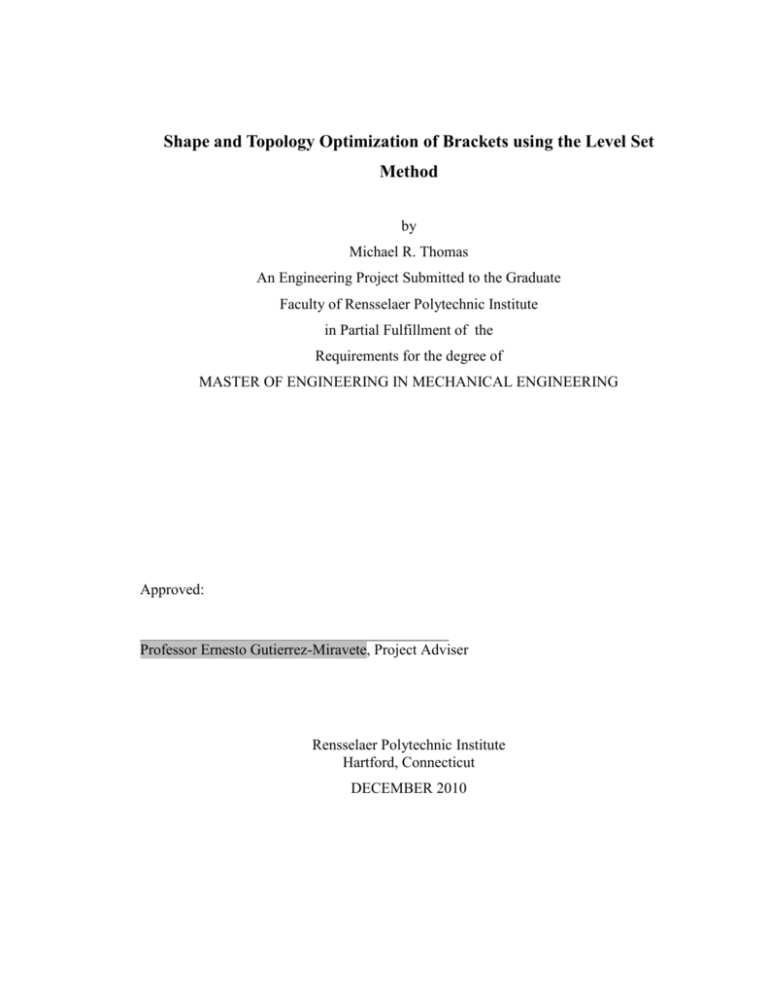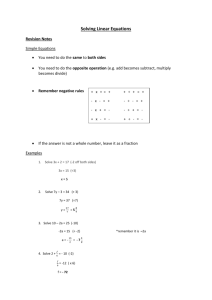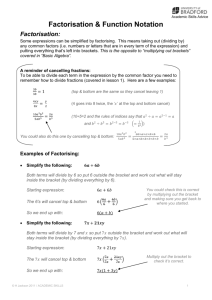
Shape and Topology Optimization of Brackets using the Level Set
Method
by
Michael R. Thomas
An Engineering Project Submitted to the Graduate
Faculty of Rensselaer Polytechnic Institute
in Partial Fulfillment of the
Requirements for the degree of
MASTER OF ENGINEERING IN MECHANICAL ENGINEERING
Approved:
_________________________________________
Professor Ernesto Gutierrez-Miravete, Project Adviser
Rensselaer Polytechnic Institute
Hartford, Connecticut
DECEMBER 2010
© Copyright 2010
by
Michael R. Thomas
All Rights Reserved
ii
CONTENTS
LIST OF TABLES ............................................................................................................ iv
LIST OF FIGURES ........................................................................................................... v
LIST OF SYMBOLS ........................................................................................................ vi
ABSTRACT ...................................................................................................................... 1
1. Introduction.................................................................................................................... 2
1.1
Background ........................................................................................................ 2
1.2
Shape and Topology Optimization .................................................................... 2
1.3
Level Set Method using Scilab Code ................................................................. 4
2. Theory ............................................................................................................................ 5
3. Methodology .................................................................................................................. 7
3.1
Level-Set Method ............................................................................................... 7
3.2
Sample Brackets ................................................................................................. 7
4. Results and Discussion .................................................................................................. 9
4.1
Example Brackets............................................................................................... 9
4.2
Establishment of Norms ................................................................................... 12
4.3
Bracket Comparison ......................................................................................... 12
4.4
Stress Analysis using COMSOL ...................................................................... 12
5. Conclusions.................................................................................................................. 17
5.1
Summary of Results ......................................................................................... 17
iii
LIST OF TABLES
Table 1
Summary of comparison study…………………………………………16
iv
LIST OF FIGURES
Figure 1
Typical sheet metal brackets.....…………………………………………..2
Figure 2
Moving the zero Level Set…....…………………………………………..3
Figure 3
Bracket boundary conditions ……………..…………….………………..8
Figure 4
Optimization results for example bracket 1…………………...……….....9
Figure 5
Optimization results for example bracket 2………………...……….......10
Figure 6
Optimization results for example bracket 3…………………...…...…....11
Figure 7
Optimization results for example bracket 4…………………...………...11
Figure 8
Optimization results for example bracket 5…………………...…...…....12
Figure 9
Optimization results for comparison analysis bracket………….......…...13
Figure 10
Brackets for comparison analysis…………………………….....………14
Figure 11
COMSOL results for designer bracket…………………………….…....14
Figure 12
COMSOL results for triangular truss bracket………..……………….....15
Figure 13
COMSOL results for Level Set bracket…………………………….…...16
v
LIST OF SYMBOLS
Open bounded set (--)
Neumann boundary condition (--)
Dirichlet boundary condition (--)
A
Isotropic Elasticity Tensor, (psi)
Strain tensor, (in/in)
u
Displacement field, (in)
f
Vector valued volume forces, (lbf)
g
Surface loads, (lbf)
Symmetric Matrix (--)
Lame’s first parameter, (psi)
Lame’s second parameter, (psi)
tr
Trace function, (--)
I
Identify matrix, (--)
t
Time, (sec)
D
Working domain, (--)
V
Fixed Volume, (in3)
Lagrange multiplier, (--)
Lagrange multiplier, (--)
Optimization boundary, (--)
H
Mean curvature of boundary, (--)
n
Unit vector normal to surface, (--)
Level set function, (--)
vi
ABSTRACT
Sheet metal brackets are used extensively in the Aerospace industry to fixture
components and plumbing to the structural shell of aircrafts or engines. Lightening
holes are commonly utilized in sheet metal structures to minimize the weight of
brackets. The shape and pattern of these lightening holes are usually left to the
prerogative of the design engineer. Time constraints typically do not permit multiple
iterations which can result in non-optimized designs. Shape and topology optimization
by the level set method was reviewed as a tool to converge on the ideal lightening hole
configuration. Through the use of the Scilab code developed by Karmann et al. [1], the
level set methodology was tested on five sample brackets. The Level set method was
able to successfully display its optimization capabilities and basic bracket construction
norms could be derived from viewing the results.
1
1. Introduction
1.1 Background
Since weight is a critical parameter in aerospace application, it is important to have
lightweight but structurally sound brackets. Lightening holes are traditionally utilized to
minimize weight of brackets. The shape and quantity of these holes is typically left up
to the designer's discretion. This can lead to inefficient bracket designs. Traditionally,
shape and topology of brackets is established by a manual iterative approach.
A
designer would make an initial guess, analyze the bracket, then adjust the shape
accordingly.
Recent developments utilizing the level-set method show promise to
employ optimization codes to establish the shape and topology of brackets.
Figure 1: Typical Sheet Metal Brackets [8]
1.2 Shape and Topology Optimization
The goal of shape and topology optimization is to find the ideal structure where weight
has been minimized and strength has been maximized. This is accomplished by iterating
on the shape and topology of a structure until the model converges to the optimum
arrangement. For structural shape and topology optimization, various methods have
been studied. Four popular methods are the homogenization method, solid isotropic
microstructure with penalty (SIMP) method, evolutionary structural optimization (ESO),
and the level set method [2, 3].
2
The homogenization method introduces a porous structure where the optimization is
simplified by increasing or decreasing the size of the pores. This method is effective at
deleting and adding holes in a structure but in more complicated structures, can result in
something that is not manufacturable. Another downside to this method is that it can
create intermediate densities [3].
The SIMP method was developed as an improvement to the homogenization method.
This method penalizes regions of intermediate densities to converge on a more solid
structure.
The evolutionary structural optimization approach starts with an initial finite element
model. Based on the specific objective function, the elements with the least contribution
are removed. This method is very effective at obtaining a local optimized structure but
may not achieve the global optimized structure.
This project will review the use of the level set method in shape and topology
optimization. The level set function was first established by Osher and Sethian to
numerically track moving boundaries [4].
The function represents the structure as a
moving boundary embedded in a higher order level set function. Complicated shape and
topology changes are easily handled by moving the zero level set up or down within the
higher order function as shown in Figure 2.
Figure 2: Moving the zero level set [7]
3
1.3 Level Set Method using Scilab Code
Scilab is a free, numerical computation software similar to Matlab. This project utilized
the freely-distributed Scilab code developed by Karrman [1] based on the work from
Allaire [4].
4
2. Theory
The approach used for this project was developed by Allaire [2] and independently
verified by Wang among others [3]. The problem is set on an open bounded set, Ω, of
real numbers. Dirichlet and Neumann boundary conditions are applied on the boundary
∂Ω.
(1)
(2)
The displacement field u in Ω is the solution of (3) where A is defined from Hooke’s law
and the strain tensor is defined by (5)
(3)
(4)
(5)
The objective function used in the Scilab code is the compliance with volume and
perimeter constraints. The total amount of work done (the compliance) is
(6)
For a fixed volume, all admissible shapes are defined by Uad:
(7)
The optimization problem, with the addition of volume and perimeter Lagrange
constraints, becomes the objective function minimization problem
(10)
The shape derivative is used to solve the optimization problem
(11)
To track the shape and topology of the structure, the level set function defined as
5
(12)
is used.
Time is introduced into the optimization code as an iteration parameter. At any time t,
the boundary is represented by the zero level set.
(13)
By setting the volume equal to:
V ( ' H Ae(u ) e(u ))
the shape derivative (11) is used to solve (13).
6
(14)
3. Methodology
3.1 Level-Set Method
This project used the level set method through the Karmann/Allaire Scilab code to
search for the optimum bracket structure for various test cases.
The optimum
arrangement is dependent on the type of structure being analyzed, and the boundary
loads and constraints. For this project, the goal is to minimize weight (Volume) and
maximize strength. The code accomplishes this by sequentially creating linear elastic
structures that when iterated on, minimize the objective function [2].
3.2 Sample Brackets
Five example brackets were selected with the goal of identifying and understanding key
characteristics of an optimized bracket. Figure 3 shows these examples with their
constraints and applied loads. The first three brackets were chosen because they are
commonly seen examples in shape and topology optimization as well as readily
available examples provided by Karmann/Alliare. The 4th and 5th brackets were chosen
to get an appreciation for the effect of different loadings. The final bracket shown in
Figure 3 is the bracket that was used for a comparison analysis. This bracket was chosen
because it was not clear what the optimum structure should look like so a reasonable
comparison of the Level Set capability could be achieved.
7
Figure 3: Bracket boundary conditions
Example one is a simple cantilever beam with the left hand side fixed and a downward
force applied to the center of the right hand side. Example two has a downward force
applied to the center of the bottom edge. The bottom left hand corner is fixed in the x
and y direction and the bottom right is fixed in the y direction. Example three has the
left hand side fixed with opposing forces applied to the right hand side. A downward
force is applied to the bottom right corner and an upward force is applied to the top right
corner. Bracket example four has the left hand side fixed with two forces applied to the
top right corner. One force is upward and the other is to the right. Example five is the
same as example four except the horizontal force horizontal is moved to the lower right
hand corner. The last bracket in Figure 3 has a downward force applied to the center of
the bottom edge and a horizontal force applied to the top right corner. The bottom left
hand corner is fixed in the x and y direction and the bottom right is fixed in the y
direction.
8
4. Results and Discussion
4.1 Example Brackets
Figure 4 shows the optimization process for example 1, the cantilever beam. The
optimization starts with an initial guess of holes. One limitation of this code is the final
structure is highly dependent on the initial guess. The code can easily handle combining
holes and morphing the shape and topology but struggles to add new holes. If the initial
guess isn’t ideal, it may not converge on the optimum solution [2]. Recent work on
structural optimization using the level set function by Wang S. et al. shows this
dependency can be minimized or eliminated by introducing radial based functions [7].
As can be seen through the results below, by the 6th iteration, the optimization code has
almost converged on the final solution. This is also evident by viewing the convergence
history that shows the objective function for each iteration.
Figure 4: Optimization Results for Example Bracket 1
9
As can be seen in Figure 5, the optimal structure for example 2 looks like a bridge.
Unlike example one, the convergence history shows the objective function actually
increased at certain time steps. This is attributed to thin members breaking apart and
combining to form larger holes. This shows the power of this optimization approach to
overcome local minima and converge towards the global minimum.
Figure 5: Optimization Results for Example Bracket 2
Example 3 shown in Figure 6 shows the level set optimization converged to a truss
structure consisting of triangular members. As expected with the opposing loads at the
top and bottom of the right side the final structure was symmetric.
10
Figure 6: Optimization Results for Example Bracket 3
Example 4 shown in Figure 7 shows the optimization code converged to a simple
triangular shape. This example also shows the code was able to overcome a local
minima and reduce the objective another 10% towards the final solution.
Figure 7: Optimization Results for Example Bracket 4
Example 5 is shown in Figure 8. As with the previous examples, a truss structure with
triangular elements comprised the optimized bracket. Example brackets 3, 4 and 5 were
intentionally similar with the exception of the applied loads. This was done to gain an
appreciation of how the structure changes with respect to the applied loads.
In each
example the quantity, thickness, and orientation of the structural members changed
significantly to counteract the applied loads.
11
Figure 8: Optimization Results for Example Bracket 5
4.2 Establishment of Norms
The five example brackets showed that a truss structure comprised mostly of triangular
members is the optimum approach for designing brackets.
This agrees well with
established practice in structural engineering. In each example, the stiffening members
generally aligned to form triangles to counteract the applied forces and distribute the
stress evenly throughout the structure. One of the objectives of the project was to
establish some basic norms for designing brackets, specifically lightening holes. The
example brackets, specifically 3, 4 and 5, show a limitation of using established norms.
Though it’s clear the optimum bracket should be comprised of a triangular truss
structure, the arrangement of the stiffening members is highly dependent on the applied
load. The norm of using triangular shaped lightening holes can not guarantee they will
be applied correctly without using an optimization methodology like the Level set.
4.3 Bracket Comparison
The comparison bracket, shown in Figure 3 was utilized to compare the capability of the
code against a typical bracket design and another design based off the observation that a
triangular truss structure is ideal. The goal was to confirm the capability of the level set
methodology for shape and topology optimization. Figure 9 shows the results of the
Scilab optimization. The number of iterations ran for this bracket was increased to 80 to
ensure it converges on the optimum structure. The increase in the objective function
12
around the 50th iteration can be explained by the breaking of one of the structural
members. The final structure was analyzed in COMSOL using a plane stress assumption.
Figure 9: Optimization Results for Comparison Analysis Bracket
4.4 Stress Analysis using COMSOL
COMSOL was used to compare the three brackets shown in Figure 10. These brackets
represent three versions of the comparison bracket shown in Figure 3.
The first
represents a typical bracket design with a lightening hole to minimize weight. The
second bracket represents a bracket created knowing the ideal design should be a
triangular truss structure. The third bracket design was obtained using the level set
method via the Karmann/Allaire Scilab code. The weight (volume) of the brackets were
kept constant to independently review the structural capability.
13
Figure 10: Brackets for comparison analysis
The total displacement results for the first bracket are shown Figure 11. As can be seen
from the Figure, the largest displacement was concentrated near the load applied at the
center of the bottom edge.
Figure 11: COMSOL results for Designer Bracket
The total displacement results for the bracket derived from the second bracket are shown
in Figure 12. This bracket has additional stiffening members which helped counteract
the load at the center of the bottom edge and distribute the displacement better
throughout the bracket.
14
Figure 12: COMSOL results for triangular truss bracket
Figure 13 shows the total displacement results for the bracket optimized using the Scilab
code. As seen in this Figure, the displacement is well distributed throughout the bracket
compared to the previous two examples. This is expected since the goal of the objective
function is to minimize compliance.
15
Figure 13: COMSOL results for Level Set bracket
Table 1: Summary of comparison study
Displacement (in)
Bracket 1: Designer
Bracket 2: Triangular
Bracket 3: Optimized
Top, Right
0.00461
0.00114
0.00110
Bottom, Center
0.01486
0.00145
0.00118
Table 1 shows the summary of the displacement at the two load points. As expected,
from a total displacement perspective, this first bracket did not fair as well as the others.
The displacement at the bottom center was greater by a factor of 10. This underscores
the importance of optimizing a bracket design for the applied loading conditions. The
second bracket based of the triangular truss structure faired quite well when compared to
the optimized bracket. The total displacement at top load was only 3% greater, however
at the bottom load, the total displacement was 33% greater. This displays how a well
structured optimization code can outperform any design standard by adjusting the
location and thickness of the stiffening members to fit the specific problem.
16
5. Conclusions
5.1 Summary of Results
The level set method was first tested on five example brackets. Through these examples,
it was evident the level set method is capable of shape and topology optimization. From
an initialization of round holes, the code quickly morphed the structure into a truss style
bracket, arranging the stiffening members with respect to the applied loads and
constraints.
Through these example brackets, it was evident the ideal approach to minimize the
weight of a bracket was to create a structure comprised of triangular truss members.
This agrees with established structural engineering practices.
A comparison analysis was performed on the three brackets shown in Figure 10 using
COMSOL to test the capability of the Level Set method to minimize the objective
function. As can be seen by comparing Figures 11, 12, and 13, the optimization code
was able to evenly distribute the total displacement throughout the bracket structure.
The code was also able to limit the total displacement at the load points better than the
other two brackets.
17
References
[1] Karrmann A. (2009). Structural optimization using sensitivity analysis Structural
optimization using sensitivity analysis and a level-set method, in Scilab and Matlab
[2] Allaire G., Jouve F., Toader A. (2004). Structural optimization using sensitivity
analysis and a level set method, J. Comp. Phys., Vol 194/1, 363{393
[3] Wang M., Wang X. (2003). A level set method for structural topology optimization
[4] Osher S., Sethian J. (1988). Front propogation with curvature-dependent speed:
Algorithms based on Hamilton-Jacobi formulations, J Comp. Physics Vol 79 12-49
[5] Demers T. (2009). A Designer’s Approach for Optimizing an End-Loaded Cantilever
Beam while Achieving Structural Requirements
[6] Wang S., Lim K., Khoo B., Wang M. (2007). An extended level set method for
shape and topology optimization, J Comp. Physics Vol 221 395-421
[7] Wang M. (2004). Physical Modeling and Optimization of Heterogenous Solid. Level
Set Methods, 2004 International Conference on Manufacturing Automation.
[8] Giddens. (2009). Giddens Capabilities. Retrieved from
http://www.giddens.com/Capabilities.aspx
18





